Facts for UPSC Mains
Air Pollution and Mortality in Indian Cities
- 08 Jul 2024
- 3 min read
Why in News?
Recently, Lancet has published a first multi-city study examining the relationship between short-term air pollution (PM2.5) exposure and mortality in 10 major cities of India between 2008 and 2019.
What are the Key findings of the Study?
- Air Pollution Causing Death: The study revealed that over 33,000 deaths (approximately 7.2% of total mortalities) could be attributed to air pollution annually across the 10 investigated cities.
- Highest Mortality Burden: Delhi, exhibited the most severe air pollution, with a staggering 11.5% (12,000 deaths) of annual deaths linked to air pollution.
- Shimla Lowest Mortality: Shimla emerged as the city with the lowest mortality burden attributable to air pollution, with only 59 deaths (constituting 3.7% of total deaths) annually.
- Chronic Exceedance of Safe Air Quality Standards: There has been a persistent violation of established air quality standards. PM2.5 concentrations consistently exceeded the World Health Organization's (WHO) safe limit (15 μg/m³) on an alarming 99.8% of the days analyzed.
- Deteriorating Health with Increasing Pollution Levels: Every 10 μg/m³ increase in PM2.5 concentration demonstrably resulted in a 1.42% rise in mortality across the ten cities.
- Cities with comparatively lower pollution levels, such as Bengaluru and Shimla, exhibited a heightened susceptibility to mortality increases with even incremental rises in PM2.5 concentrations.
Read More: Advancing Air Pollution Control in India, World Air Quality Report 2023
UPSC Civil Services Examination Previous Year Question (PYQ)
Prelims
Q. In the cities of our country, which among the following atmospheric gases are normally considered in calculating the value of Air Quality Index? (2016)
- Carbon dioxide
- Carbon monoxide
- Nitrogen dioxide
- Sulfur dioxide
- Methane
Select the correct answer using the code given below:
(a) 1, 2 and 3 only
(b) 2, 3 and 4 only
(c) 1, 4 and 5 only
(d) 1, 2, 3, 4 and 5
Ans: (b)
Mains
Q. Describe the key points of the revised Global Air Quality Guidelines (AQGs) recently released by the World Health Organisation (WHO). How are these different from its last update in 2005? What changes in India’s National Clean Air Programme are required to achieve revised standards? (2021)





